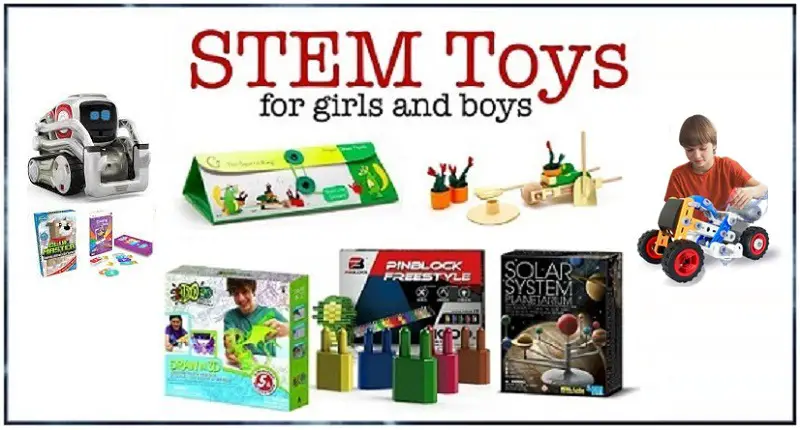
STEM toys for kids are educational toys that are designed to teach children useful Science, Technology, Engineering, and Mathematics (STEM) concepts. STEM toys are available in various forms, including building sets, coding robots, science kits, puzzles, and electronic circuitry kits.
STEM concepts are best learned by seeing and doing things practically. Use these learning resources and toys to teach your kids about the human body, living creatures, planet earth, solar system, electronics, and more. The best Science (STEM) toys, kits, games & resources for the young, creative minds.
The aim of these toys is to encourage children to explore STEM principles in a playful way.
Types of STEM Toys & Games
Here are some cool Toys which will ensure that science remains a fun topic all the time.
- Start scientific conversations with your kids
- Excellent introduction to Science and Electronics
- Provide hours of quality time for your kids
- Some of the activities may require direct parent involvement
STEM Toy Categories
Robots
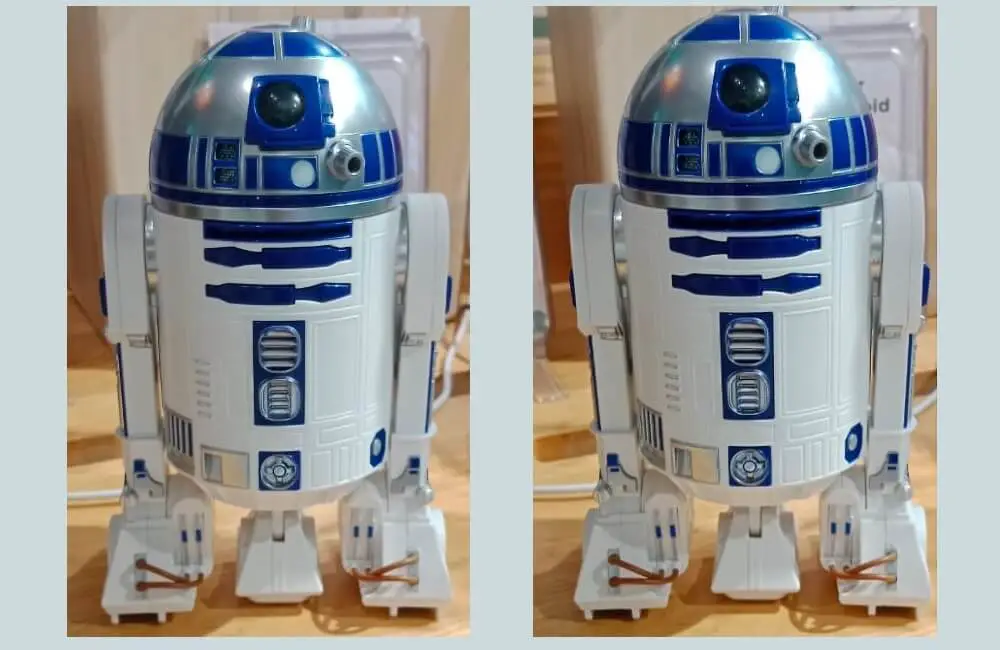 With Robot toys, children will use both sides of their brain to learn about geometry, shapes and more. Robots can talk, respond, draw a picture. You can even connect the toy robot to your computer or tablet using the built-in wifi and see the robot unleash its creativity.
With Robot toys, children will use both sides of their brain to learn about geometry, shapes and more. Robots can talk, respond, draw a picture. You can even connect the toy robot to your computer or tablet using the built-in wifi and see the robot unleash its creativity.
Best Robot Toys for Kids (Robots and Robotic Kits)
Hexbug Toys
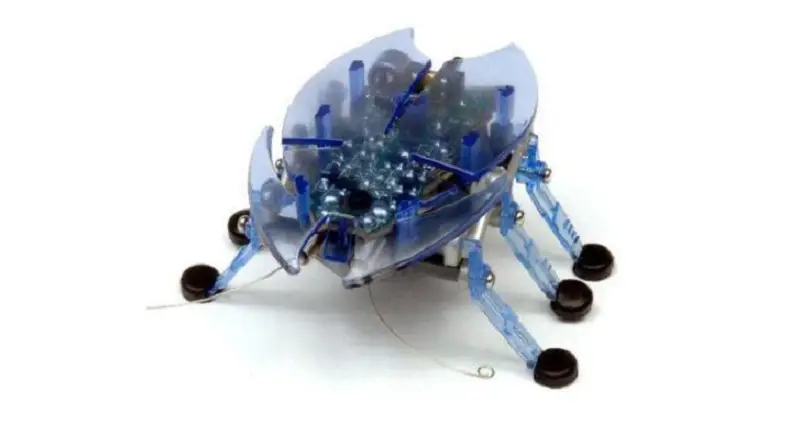 Hexbug toys include small, insect-like robots that move and mimic the behavior of real bugs. Hexbug toys can crawl, creep, and navigate around corners, providing a fun and entertaining experience for users.
Hexbug toys include small, insect-like robots that move and mimic the behavior of real bugs. Hexbug toys can crawl, creep, and navigate around corners, providing a fun and entertaining experience for users.
Pocket Microscope
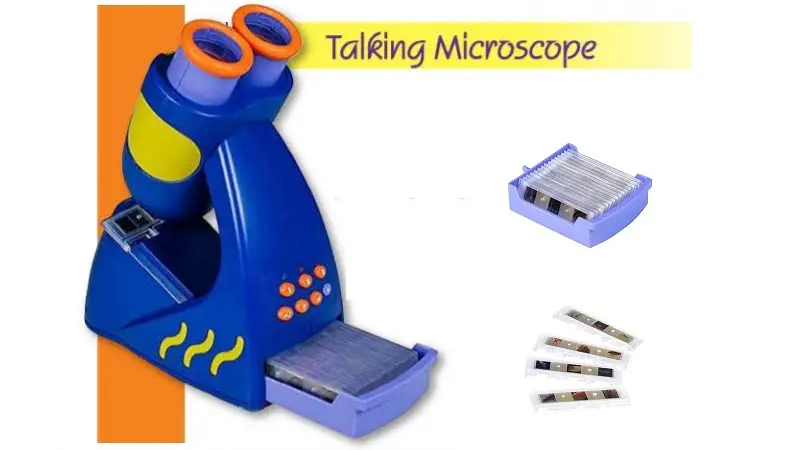 A pocket telescope and microscope combines two scientific instruments in one! Use the whole ‘pen style’ unit as a telescope to view distant objects at 8X magnification. To take a closer look at bugs and objects, remove the end to reveal a mini telescope boosting 30X magnification.
A pocket telescope and microscope combines two scientific instruments in one! Use the whole ‘pen style’ unit as a telescope to view distant objects at 8X magnification. To take a closer look at bugs and objects, remove the end to reveal a mini telescope boosting 30X magnification.
Magnetic toys
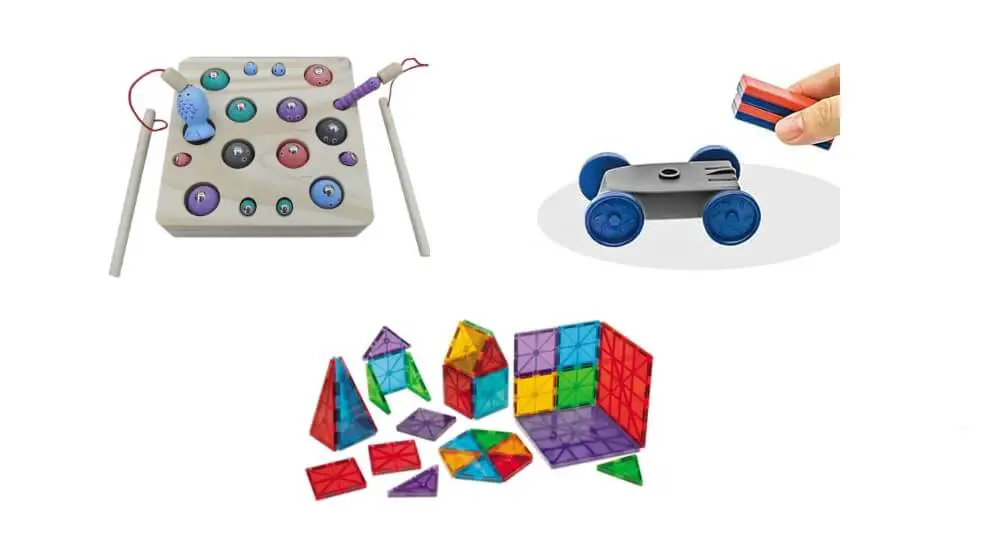 Magnetic toys include magnetic components that can attract or repel each other and can be used for building, creating, and exploring. You get magnetic construction sets with several different ways to build. These allow children to engage in hands-on activities and develop their fine motor skills, creativity, and problem-solving abilities.
Magnetic toys include magnetic components that can attract or repel each other and can be used for building, creating, and exploring. You get magnetic construction sets with several different ways to build. These allow children to engage in hands-on activities and develop their fine motor skills, creativity, and problem-solving abilities.
Solar Powered Toys
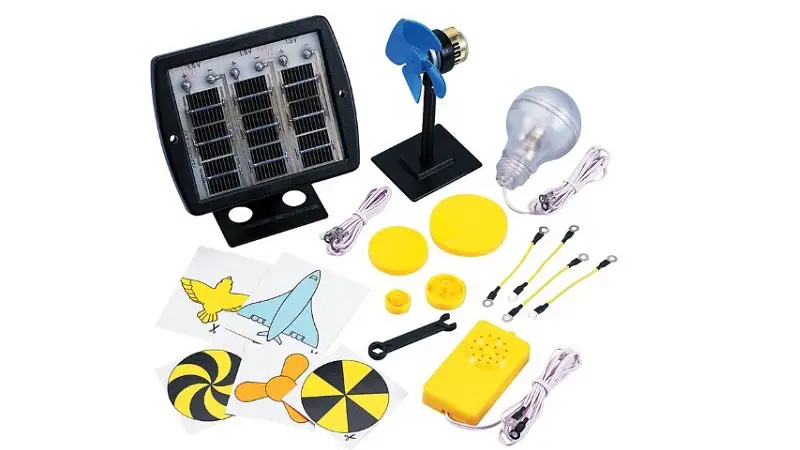 Solar powered toys utilize solar energy as a power source by using small solar panels to capture sunlight and convert it into electrical energy to power the toy’s functions. Solar powered toys are educational, environmentally friendly and entertaining alternatives to battery-operated toys.
Solar powered toys utilize solar energy as a power source by using small solar panels to capture sunlight and convert it into electrical energy to power the toy’s functions. Solar powered toys are educational, environmentally friendly and entertaining alternatives to battery-operated toys.
Best Solar Powered Toys & Kits for Kids
Windmill Toys for Kids
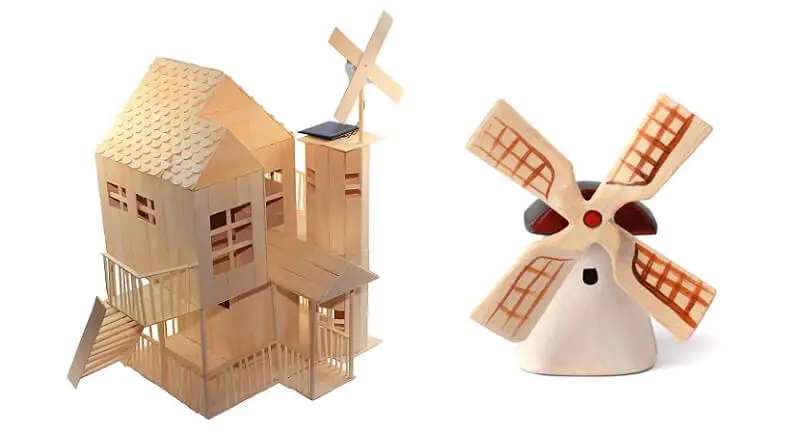 Windmill toys resemble windmills, which are structures that use wind to generate power or pump water. Windmill toys spin when there is a breeze or when they are moved by hand. They can be made of different materials, such as paper, plastic, wood, or metal. Some windmill toys are also educational, as they can demonstrate how wind energy works or how to make electricity from flowing air.
Windmill toys resemble windmills, which are structures that use wind to generate power or pump water. Windmill toys spin when there is a breeze or when they are moved by hand. They can be made of different materials, such as paper, plastic, wood, or metal. Some windmill toys are also educational, as they can demonstrate how wind energy works or how to make electricity from flowing air.
Checkout the best Windmill Toys for Kids
Construction Toys
Construction toys enable children to engage in building and construction activities, and builds problem-solving skills, builds spatial awareness, and improves creativity. These construction sets include components that can be connected, stacked, or assembled to create various structures, vehicles, and designs.
Checkout more construction toys here.
Digital Cameras for Kids
 Kids cameras are specially designed cameras for children to explore and enjoy the world of photography. These cameras have a child-friendly design with bright colors, playful shapes, and easy-to-use buttons, and featuring durable materials and shockproof casings.
Kids cameras are specially designed cameras for children to explore and enjoy the world of photography. These cameras have a child-friendly design with bright colors, playful shapes, and easy-to-use buttons, and featuring durable materials and shockproof casings.
Checkout the best Cameras for Kids
Spy Glasses for Kids
 Spy glasses for kids are great for imaginative play and creativity. These feature mirrored outer edges that reflect what is behind the wearer, making them great for kids’ detective or spy games.
Spy glasses for kids are great for imaginative play and creativity. These feature mirrored outer edges that reflect what is behind the wearer, making them great for kids’ detective or spy games.
Binoculars for Kids
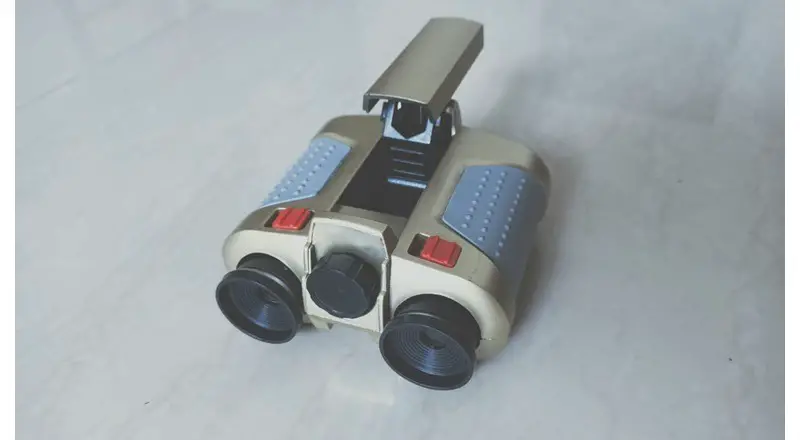 Binoculars for kids often come with features that make them suitable for young users. These are designed to withstand rough handling, have adjustable focus, and compact size for easy handling by small hands.
Binoculars for kids often come with features that make them suitable for young users. These are designed to withstand rough handling, have adjustable focus, and compact size for easy handling by small hands.
Telescope shaped Projector
 View all 12 Zodiac constellations from your room with a telescope shaped projector. The constellations can be projected onto any surface in three different modes: celestial, connected and illustrated. It also projects the sun, moon and planets. A red LED at the back of the projector lets you read the activity book in the dark.
View all 12 Zodiac constellations from your room with a telescope shaped projector. The constellations can be projected onto any surface in three different modes: celestial, connected and illustrated. It also projects the sun, moon and planets. A red LED at the back of the projector lets you read the activity book in the dark.
Space and Astronomy Toys for Kids
 These toys, kits and puzzles provide fun and educational experiences, these educational toys serve as learning aid that help kids learn about the solar system. You also get kits that allow kids to create their own solar system model and learn about planets and space science.
These toys, kits and puzzles provide fun and educational experiences, these educational toys serve as learning aid that help kids learn about the solar system. You also get kits that allow kids to create their own solar system model and learn about planets and space science.
Best Space and Astronomy Toys for Kids
Chemistry Sets for Kids
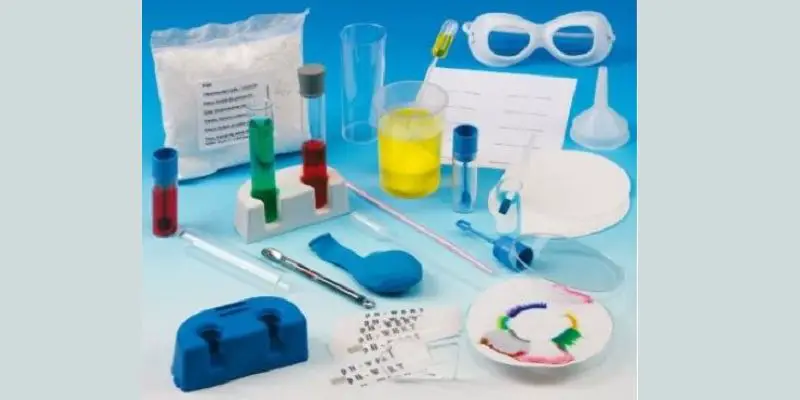 Chemistry sets for children allow kids to learn principles and concepts of chemistry through experiments and activities. These sets typically include age-appropriate chemicals, laboratory equipment such as test tubes and measuring cups, and detailed instructions for conducting experiments.
Chemistry sets for children allow kids to learn principles and concepts of chemistry through experiments and activities. These sets typically include age-appropriate chemicals, laboratory equipment such as test tubes and measuring cups, and detailed instructions for conducting experiments.
Checkout the best Chemistry Sets for kids
Gross Science Experiments & Squishy Toys
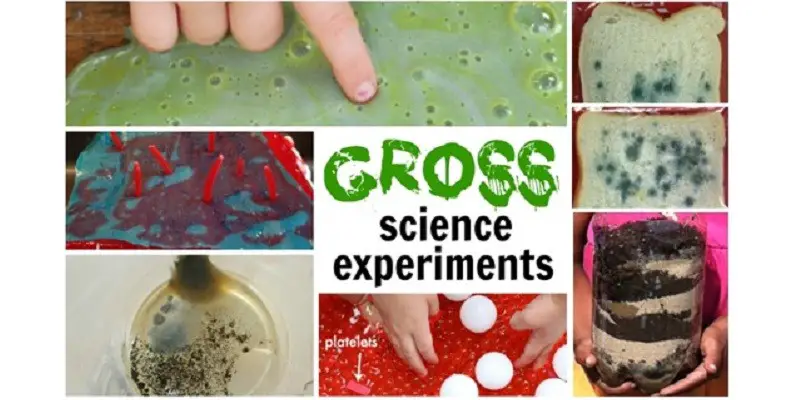 Gross science experiments and squishy toys are elements often found in science kits designed to engage children in hands-on learning experiences. These experiments are activities teach scientific concepts in a way that is intentionally “gross” or unconventional, and often focus on topics such as bodily functions, slimy substances, or unusual reactions.
Gross science experiments and squishy toys are elements often found in science kits designed to engage children in hands-on learning experiences. These experiments are activities teach scientific concepts in a way that is intentionally “gross” or unconventional, and often focus on topics such as bodily functions, slimy substances, or unusual reactions.
Best gross science experiments and squishy toys for kids
Physics Sets for Kids
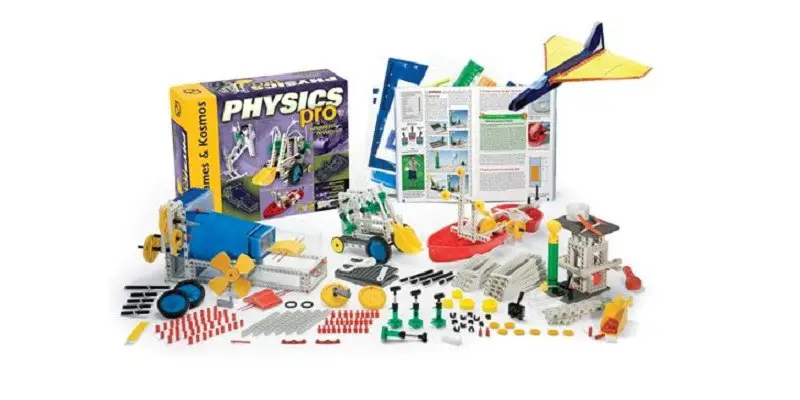 Physics science sets for kids demonstrate the principles of physics through fun experiments and activities. These sets include materials, components, and instructions for conducting experiments and building models related to various physics concepts such as electricity, magnetism, simple machines, and more.
Physics science sets for kids demonstrate the principles of physics through fun experiments and activities. These sets include materials, components, and instructions for conducting experiments and building models related to various physics concepts such as electricity, magnetism, simple machines, and more.
Checkout the best Physics Sets for Kids
Volcanic kits for Kids
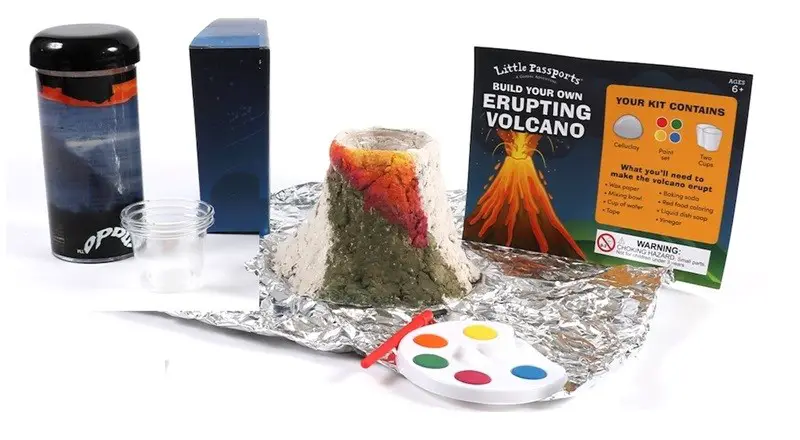 Volcanic kits for kids allow children to learn about volcanoes through simulated volcanic eruptions. These kits typically include materials and instructions for creating a model volcano. Some kits also come with paints and paintbrushes for decorating the volcano.
Volcanic kits for kids allow children to learn about volcanoes through simulated volcanic eruptions. These kits typically include materials and instructions for creating a model volcano. Some kits also come with paints and paintbrushes for decorating the volcano.
Checkout the best Volcanic kits for kids
Human Body (Anatomy) Toys for Kids
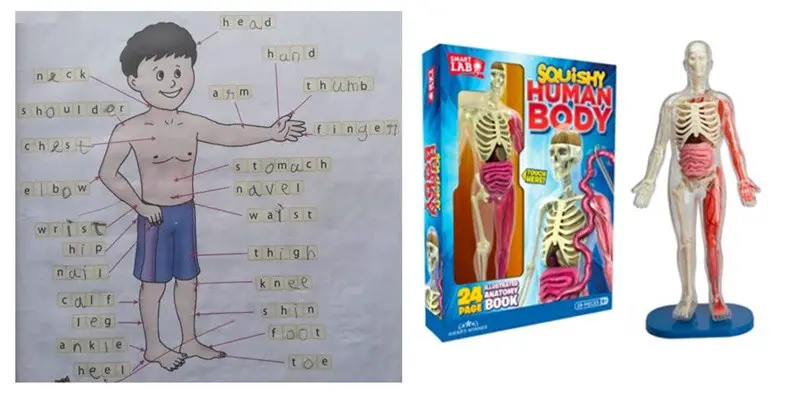 These toys help teach kids about the human body and anatomy. You can choose from a wide range of options.
These toys help teach kids about the human body and anatomy. You can choose from a wide range of options.
Best Human Body Toys & Kits for Kids
Electronic kits for kids
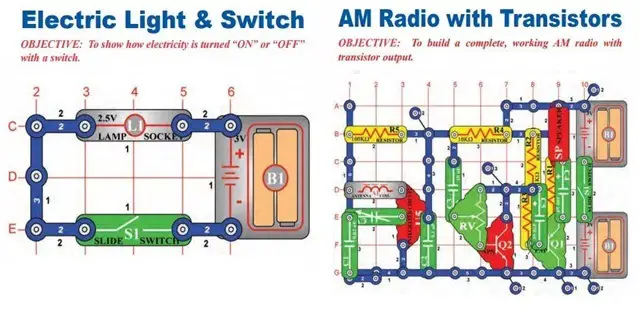 Electronic kits for kids are educational toys that teach concepts related to electronics and technology. These kit include components to build electronic circuits and devices in a safe manner.
Electronic kits for kids are educational toys that teach concepts related to electronics and technology. These kit include components to build electronic circuits and devices in a safe manner.
Best electronic and electric kits for Kids
Tablets and Laptops for Kids
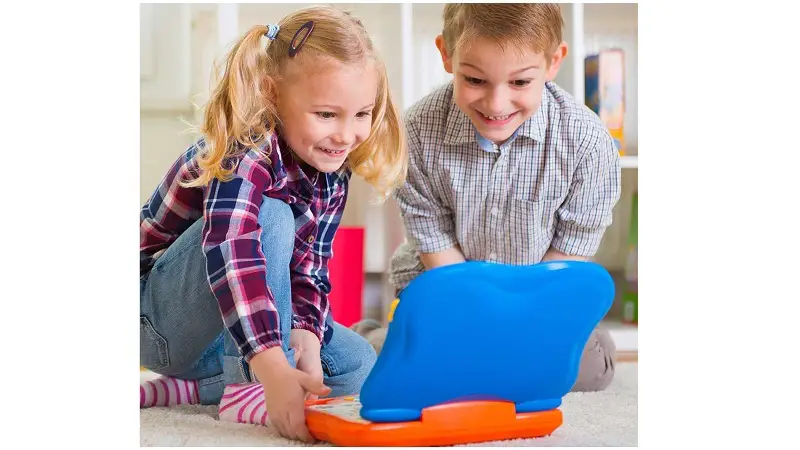 Educational tablets and laptops designed specifically for kids. These tablets are suitable for younger children and offer a range of educational and entertainment options. It is important to prioritize features that are suitable for your child’s age group and educational needs.
Educational tablets and laptops designed specifically for kids. These tablets are suitable for younger children and offer a range of educational and entertainment options. It is important to prioritize features that are suitable for your child’s age group and educational needs.
Best Educational Laptops and Tablets for for Kids
Kids headphones
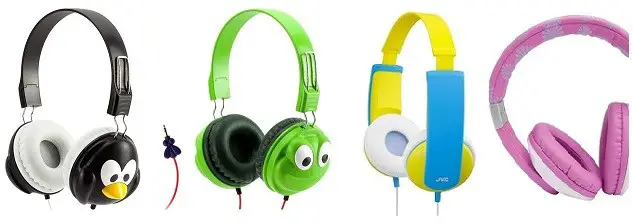 Kids headphones are specially designed to meet the unique needs of young listeners and can be used while listening to music, watching vies or playing games. These are colorful and are available in wired as well as wireless options.
Kids headphones are specially designed to meet the unique needs of young listeners and can be used while listening to music, watching vies or playing games. These are colorful and are available in wired as well as wireless options.
More Categories of Science Toys
Early Development Science Toys
Physics Science Kits
Earth Sciences & Geology Science Kits
Chemistry Science Kits
Biology Science Kits
Archaeology & Paleontology Kits
- Terrariums For Kids
- Top Tech Toys for Kids
- Environment-friendly Toys: Sustainable, recyclable and plant-based
- Fischertechnik Engineering Kits for Kids: Middle and High School Students
- Children’s Electric Circuit Kits
- Best, easy-to-use all-in-one printers for kids: Let your child’s work shine
- Top Detective Science Fingerprinting Kits for Kids
- Vehicle Robotic Kits for Kids
- Best Drones for Kids
- LeapFrog Educational Toys and Games
- Smart Toys can be hacked, here’s how to be safe with “Internet of Toys”
- Radio Controlled Hobbies: Beginner’s guide
Introduction to STEM
Every parent and teacher faces inquisitive questions from kids such as- why is the sky blue? what is a volcano? how is it formed?
Science answers all these questions for your child. Science is extremely important for every child as it explains the what’s, why’s, how’s of the world.
Science gives a reasoning to a child as to why something occurs and helps them form a firm base for further discoveries in life. It arouses a child’s curiosity and explains the importance and role of every living, non-living thing in the world.
Science plays an important role in our lives and is best learned by seeing things in reality. That is why you must make use of toys and kits to teach these important concepts to kids.
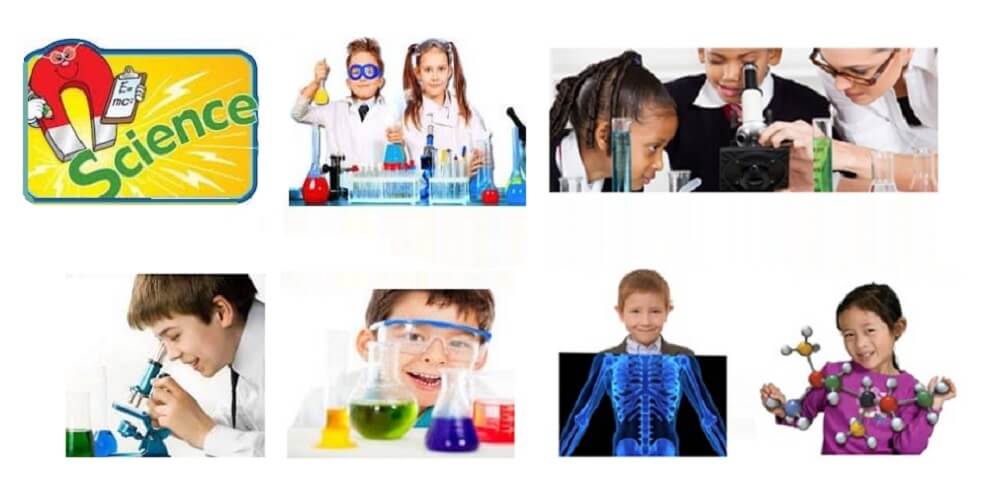
Why is STEM Education Important?
STEM is an acronym for Science, Technology, Engineering & Maths.
The STEM subjects cover almost everything that are important in our lives. Science helps us understand our natural world likes, sun, moon, earth, weather, nature, animals, human beings etc. Technology includes our gadgets, T.V., smartphones, computers etc. Engineering involves roads, bridges, transportation, buildings etc. and Math helps in banks, shops, tax, budget etc.
Studies suggest that countries with a workforce that is well-trained in the various STEM disciplines tend to be among the more economically developed countries. Expertise in STEM usually creates the next generation of innovators & thinkers, and innovation invariably helps boost the economy.
Every country needs more people who are trained in STEM fields, and STEM fields tend to be among the more rewarding professions. People with STEM related jobs tend to have higher wages.
However, in recent years, it has been observed that fewer students are focusing on STEM subjects with even fewer high school students showing interest in a STEM career.
As a result, efforts are being taken to help students understand these disciplines to prepare them for a much competitive environment of tomorrow.
Educators are trying to engage and encourage students through experimental learning activities, which also helps bring out the innovative side of students who are compelled to understand issues and come up with creative solutions for the problem.
STEM toys can play an important part in experimental learning and help generate curiosity in these subjects.
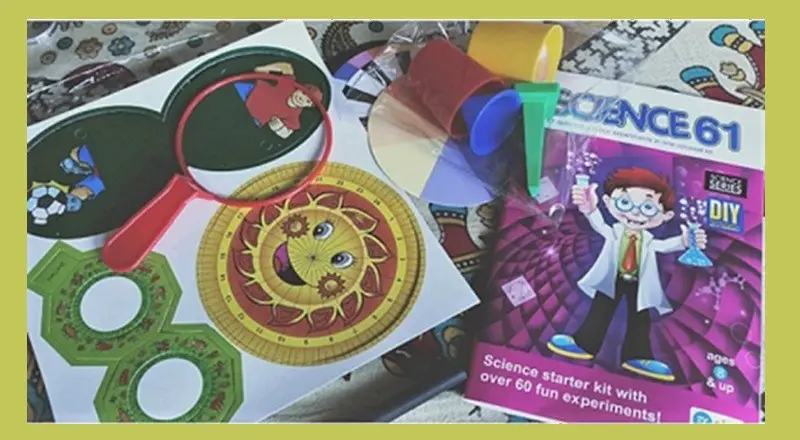
Science Fun Experiments at Home
Off late, science themed birthday parties are becoming quite popular, as parents ask for creativity, innovation alongside fun in parties. These parties are fun and entertaining, but also teach important science concepts and answers many of their questions.
You could even throw a great science themed party at home, and conduct all the fun experiments for kids, right at home.
Here are some experiments that you can do at home, along with your kids.
Tornado in a jar
This is a popular experiment among children of all ages and is pretty simple to do too.
Ingredients needed for the project: A jar, Water, A small squeeze of dish soap
Procedure: Fill the jar with water, add the squeeze of dish soap in it, close the lid of the jar and shake it and voila! You get a tornado in the jar.
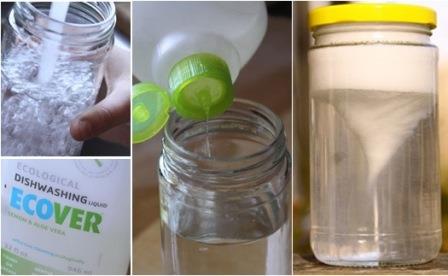
Note that you can shake the jar any way in any direction. As you twist the jar, the water inside up against the glass is pulled along due to its friction again the glass walls. The fluid toward the inside takes longer to get moving. But eventually both the glass jar and the fluid are spinning as you rotate the bottle. When you stop rotating the jar, the fluid inside keeps spinning. A mini twister can be seen for just a few seconds when the outer fluid slows down and the inner fluids continue to spin rapidly. Try it again and see!
Walking water experiment
Ingredients needed for the project: Two cups, Water (you can put some color in it), Paper towel
Procedure: Take two cups and fill one of it with water and keep the other cup completely empty. You can color the water if you wish, that way the kids can see what is happening with the water and also they will love the color. Place the cup filled with water at a slight elevation. For e.g. you can place it on top of 2-3 books. Place the empty cup below the 1st cup. Now take a paper towel and insert one end in the cup filled with water and the other end should be inserted in the empty cup. Ensure that the paper towel touches the bottom of the cup. Now just wait a while and observe. You will find that the cup filled with water, placed on the top is slowly becoming empty and the cup that was empty before is slowly filling up with the colored water.
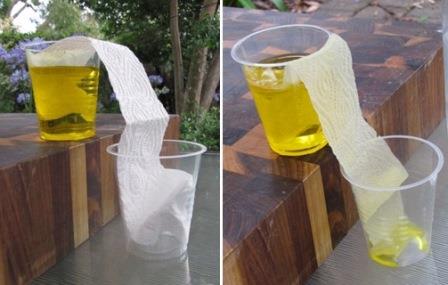
Don’t expect it to happen immediately, this experiment takes some time.
Does it dissolve?
Ingredients needed for the project: A large transparent bowl filled with water, Salt, Sugar, Rice, Flour
Procedure: The whole point of this experiment is to make children understand about ingredients that will dissolve and those that don’t. It is a simple exercise. Place a transparent bowl filled with water on a table. On a separate table place the ingredients- salt, sugar, rice, flour separately in small bowls. Now ask each child to put a spoon of each ingredient into the transparent bowl of water to see if the ingredient dissolves in it.
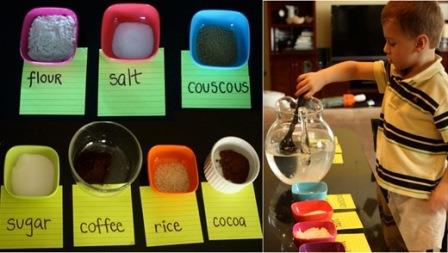
Ask the child to draw their own observation and conclusions. You can change the ingredients for each child and you may have to also change the water for each ingredient as it may become difficult to see through if all the ingredients are mixed together.
Coloring Daisies
Ingredients needed for the project: 4-5 Daisies (type of flower), Food coloring or water colors, Droppers (optional), Small cups or jars (4-5 depending on the number of daisies)
Procedure: Place one daisy each in the small jars or cups and fill the cup with a inch or slightly more of water. Using the dropper, add different colors in each jar containing the water with the daisies. Please note, add the color in the water and not on the daisies. Wait for a while and after about an hour or so you will notice the daisies changing color. As time passes by the color on the daisies will darken.
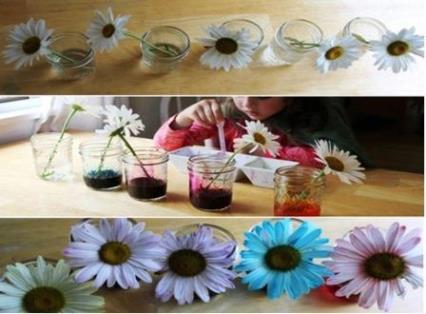
You can explain this process to the children by explaining that plants need water and take in the water and the water from the plants evaporate but the color stays because color cannot evaporate, thus leaving colored daisies.
Swirling colors
Ingredients needed for the project: Milk, Tray or shallow bowl, Food coloring, Cotton swabs, Liquid dish soap
Procedure: With this experiment you could show how different ingredients react when put together. So, you need to put some milk into a tray and add several drops of food coloring (use 2-3 different colors) in it. Now take the cotton swab and just dip it in the milk and use the same swab and dip it in the liquid soap after which you will have to dip it back in the milk tray. Don’t stir, just dip it and hold it still. You will find the colors swirling around. It is a great chemistry experiment and the kids enjoy the swirl of colors.
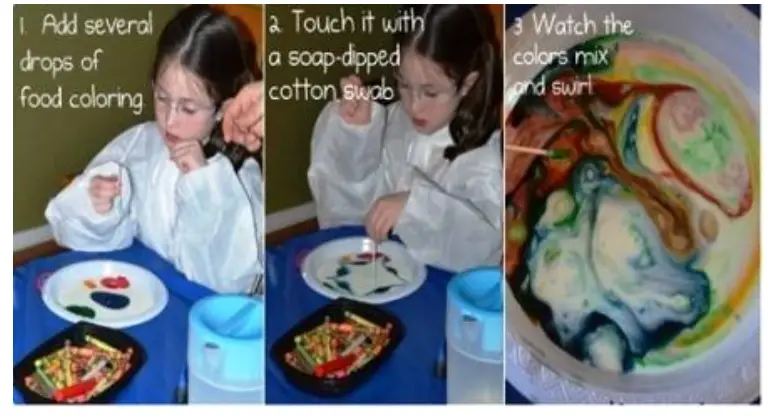
Setting Up Your Experiment Lab
If you are planning a science experiment party for your kid and his/her friends, you’ll need items/ingredients for the experiments. Here are some common items required for Science Experiment Parties:
- Lab coats
- Safety eye goggles
- Instruction manual for each experiment
- Experiment ingredients (water/ flasks/ jars/ beakers/ test tubes etc
- Clipboards/ instruction boards
- Ingredient boards
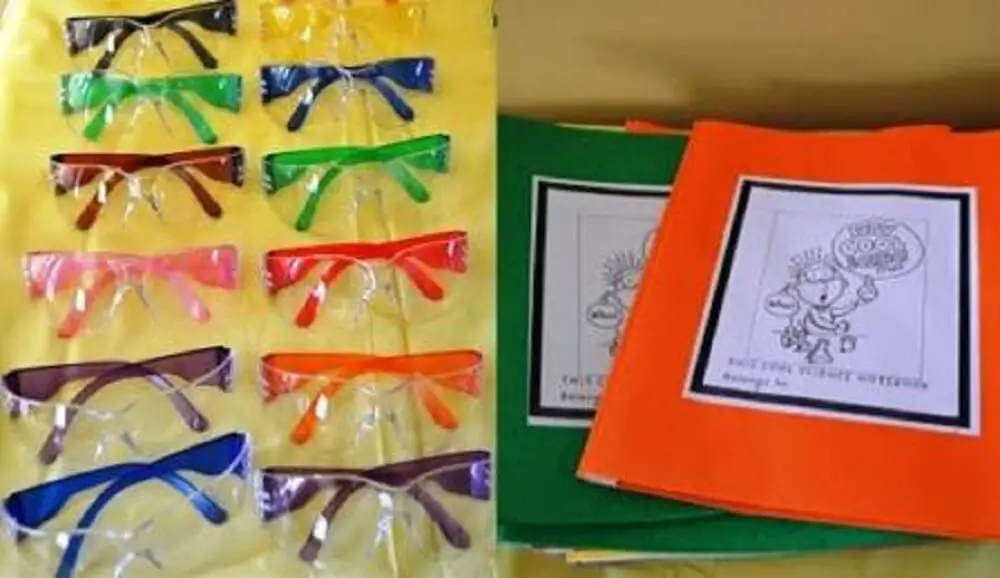
Safety Precautions for Science Experiments with Kids
Science experiments can be a lot of fun provided they are safe and doesn’t cause any harm. Be it at a lab or at home, if you are planning on a science experiment, one of the first things you should ensure is that the experiment is not a dangerous one.
- Always supervise every experiment done by every child so that if they are doing something wrong, you can always assist them.
- Make sure that the ingredients used in the experiment are not harmful, for e.g. If you are using a food item, check if any child has any food allergies, use natural food products as far as possible which don’t harm the skin of the child, check for any sharp objects such as knives, cut glass etc that could harm a child.
- Ensure that in case of any chemicals used, the children wear proper protective gear etc. Also ensure that kids don’t put any harmful objects in their mouth.
- All experiments should be conducted in a clutter free environment so that the kids have enough space to move around and there are no breakages while doing the experiment.
- Ideally, if you intend to keep a science experiment party, try out all the experiments yourself to ensure that they are completely safe and use your discretion to decide if these experiments are child friendly.
Make your child learn science through toys & games
Educational Toys, Books, Software, Games are useful supplementary resources that parents and educators can use to further their child’s educational development.
STEM toys, in particular, allow kids to conduct hands-on science experiments to explore various scientific elements, which is a great way to learn useful science concepts at an early age.
There are several science toys (Battery-powered robots, educational solar kits, electronic games and more) that help your child learn new things – fixing parts, making a plane, stethoscope, magnets, etc. that helps the child to learn important science concepts (basics of electromagnetism, magnetism, electricity, etc). These help kids apply the theories learned at school thereby reinforcing important concepts.
Science is fun to learn when taught using do it yourself (DIY) kits where they can make working models of objects. Kids, being curious, love finding out how things work, love doing hands-on projects. Teachers/educators, on the other hand, love to see kids/students excited about these activities while preparing them for a techy future.
As a result, STEM toys are not only perfect for home use but can also be used in school, for homeschooling, and for after school projects.
These toys and games are good for overall development of a child as they are encouraged to understand the process and also come up with innovative solutions to life problems. By using these toys, parents can trigger curiosity and interest among kids in these subjects.
Encourage Girls to Love STEM
In most societies, it is observed that fewer girls pursue STEM related career. Researches feel there are several factors that prevent girls from pursuing STEM careers.
- STEM careers are often time-consuming (requiring extended education) and can result in sacrifice of family life or career goals for some women. Girls need female role models who could provide encouragement and inspiration as well as demonstrate how to balance their lives between careers and family life.
- Not being encouraged by people around. In some societies, the environment is not conducive to encourage girls to pursue interests in such careers.
However, most schools and educators are working to improve the scenario.
- More schools now have quality science programs and activities that utilize hands-on materials and experiments.
- Successful female scientists are being invited to speak to classes, and girl-centered science clubs are being created to give them the confidence, support, and resources they need to achieve success.
- Parents and educators should schedule trips to science museums & summer vacation science camps as well as provide access to good female role models, mentors, & support groups.
- Parents can also help encourage their daughters by purchasing science toys, kits, and equipment for them as well as help them to do simple experiments at home or for science fair projects.
DIY STEM Activities
Here are some STEM related activities (for kids aged 4+) that you can do at home, which should get your children interested in STEM topics.
Science projects
Blowing water on wax paper experiment is a fun project that not only entertains but also explains the concept of surface tension and bonding properties of water molecules. Even if your child is too small to understand the science behind it, you can still get them to try it out because it is so much fun. All you need is a straw, waxed paper and an eye dropper or a spoon.
Steps: Place the wax paper on a flat surface and drop water droplet on it. Use the straw to blow the water on the wax paper and watch it move or break into smaller water droplets. You can also suck it back and blow them out again.
Technology projects
You can explore pictures and videos of NASA missions, with your child, on the iPad or the computer. Download the Star Walk app and teach your child about stars and constellations etc.
Engineering projects
You can ask children to make their own boat using junk items like straw, cans etc. and once done, you can put it in a tub of water to test or race it. You could also ask children to make straw bridges etc.
Read: Top Tech Toys for Kids
Math Projects
To develop your child’s interest in math, create fun projects like shape hunt, wherein you can hide various geometry shapes in different places in the room or house and give the kids a picture of the shapes which they are supposed to hunt for. A fun hunting math game. Or create a fun subtraction and addition game with your child’s favorite food items like cereal or fruit etc.There are plenty of other creative home projects that you can try out which are based on STEM education to introduce them to STEM at an early age. You can check out more projects online or refer to books for the same.
Lately, there has been a growing call to add ‘Art and Design’ to the science-related disciplines (STEM to STE’A’M). Art and design enhance creativity and is an important part of innovation, hence the need to include it.
Related: Arts for Children
Thames & Kosmos STEM Toys and Science Kits
Thames & Kosmos are experts in making educational STEM toys and kits for home-schoolers, and their portfolio includes products such as Electricity & Magnetism kits, Remote Control Machines kits, Air & Water Power kits, and more.
Thames & Kosmos Electricity & Magnetism kit
For kids aged eight+ and budding physicists, this kit allows kids to conduct over 60 experiments with circuits and magnetic contraptions as they learn about electricity and magnetism.
Signature Series Remote Control Machines
For kids aged eight and above, this kit allows kids (and adults alike) to assemble ten models, demonstrating various ways in which motors can be used. Kids can also create their own remote control creations. These machines have extraordinary quality and sturdiness.
Thames & Kosmos Air & Water Power kit
This kit allows kids (aged 8+) to build their own models powered by air and water pressure, helping them learn the laws of physics. Build air-and-water-powered systems: water-jet propelled cars, hydro-pneumo powered engines, and more.
Useful Books & Resources
Science Dictionary for Kids
When you Google for science terms, the search results may show up things that could be irrelevant. A science dictionary can be a good resource to have at home.
There are some really good science dictionaries available for kids that contain several illustrated science definitions, kid-friendly definitions and illustrations, that every child must know. These cover a range of science related topics, from the basic science equipment, to the physical sciences, to earth science, animals, robots, and more.
And these are great help for teachers and parents as well, to help children with their science homework.
Here are some of the best Science Dictionary for Kids:
- Science Dictionary for Kids: The Essential Guide to Science Terms, Concepts, and Strategies
- The Usborne Illustrated Dictionary of Science
- The Ultimate Visual Dictionary of Science
- Scholastic Science Dictionary
Funtoyworld is a family-managed website with me (Ben), and my wife doing most of the work. We are proud parents of two wonderful kids and love reviewing toys. We have a firm but friendly “democratic parenting” style and offer several practical suggestions backed by extensive research. Our own experience with raising two children prompted us to share our knowledge. Read more.
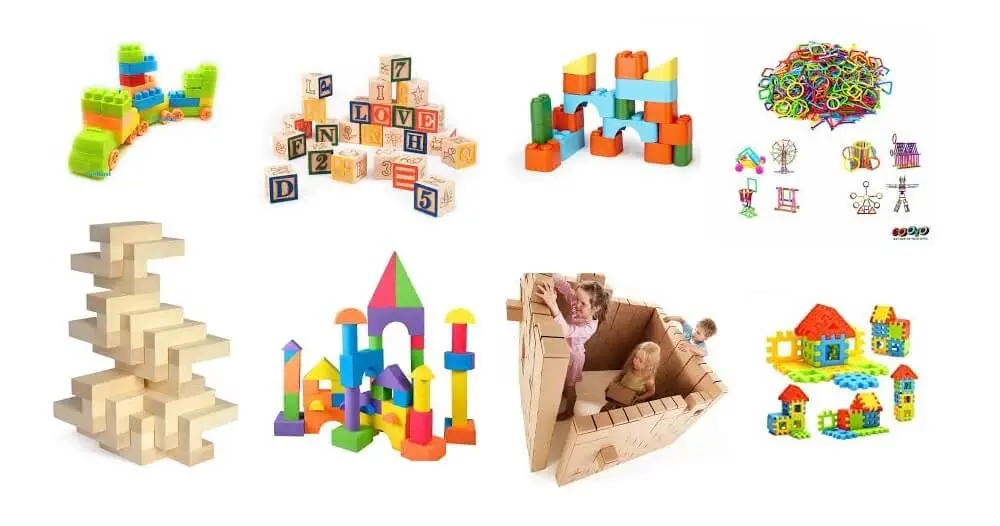
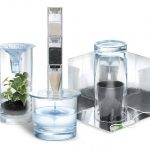
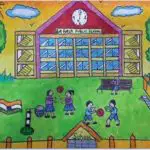
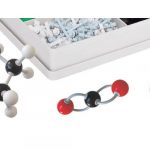
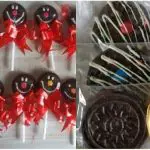

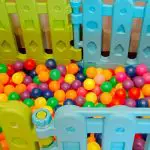
Leave a Reply